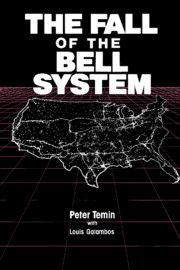Book contents
7 - Creating the new order
Published online by Cambridge University Press: 06 January 2010
Summary
Defending the agreement
The unthinkable had become thinkable, then possible, and finally – relative to Brown's view of the alternatives facing AT&T – unavoidable. Brown had agreed to abandon the Bell System and its integrated national network in order to get out from under the judicial, regulatory, and legislative guns aimed at AT&T. His acceptance of Baxter's plan was a total surprise to the ordinary citizen and the shocked members of the Reagan administration, and even to the officers of the Bell Operating Companies who were given a day or two's advance warning by Brown. It was, as well, a decision embodying a new theory of the industry. Everyone inside and outside the Bell System had grown up under Vails theory of a consolidated, universal network furnishing end-to-end service. The edges of this concept had been nibbled away over the previous decade as the Carterfone, Specialized Common Carriers, and Execunet decisions were implemented and extended, but the basic structure of the Bell System had remained largely intact. Divestiture dethroned the national integrated network in favor of competition.
According to Baxter's theory, divestiture was complete in itself. In one fell swoop, it eliminated not only the opportunities but also the incentives for anticompetitive cross-subsidization. Judge Greene, the Congress, and the FCC had been preempted; they had nothing to do but step aside gracefully and let the market work. This implication of the Modification of Final Judgment was clear to Brown and Baxter. It was less clear to the stunned observers.
- Type
- Chapter
- Information
- The Fall of the Bell SystemA Study in Prices and Politics, pp. 277 - 335Publisher: Cambridge University PressPrint publication year: 1987



